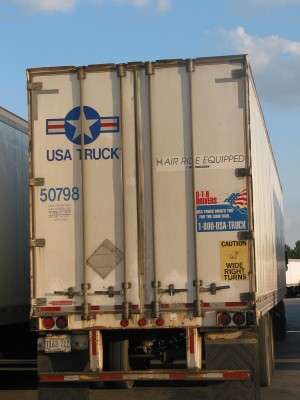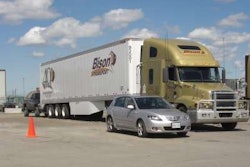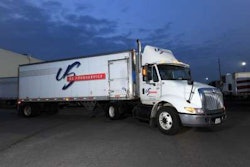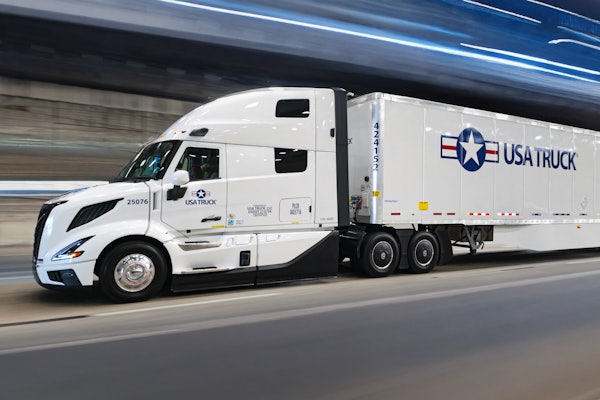 USA Truck is striving for four loads per truck each week.
USA Truck is striving for four loads per truck each week.The past few years have been tough, and USA Truck has hardly been immune. Indeed, the Van Buren, Ark.-based truckload carrier is one of the handful of trucking companies whose financial challenges are a matter of detailed public record. In the third quarter, USA Truck’s revenue was down more than 20 percent from the same 2008 quarter, and it lost $1.6 million – down from a $2.4 million profit in the third quarter of 2008. For the year through September, USA Truck has lost $4.7 million.
The basic challenge USA Truck faces is familiar to many carriers: A lack of freight demand that has created excess capacity and downward pressure on pricing. But Clifton Beckham, president and chief executive officer, says financial results and poor freight demand have overshadowed the progress the company has made through its strategic plan, which is called Vision for Economic Value Added, or VEVA. The objectives of that plan are to improve return on capital and reduce earnings volatility over time.
USA Truck has seen benefits from some of the efforts related to VEVA. For example, its “War on Accidents” safety initiative continues to drive down the carrier’s U.S. Department of Transportation recordable accident frequency, which is lower through the third quarter than it was through the same period last year; the DOT recordable rate was down 27 percent in the second quarter compared to all of 2007. Also, productivity among its nondriver work force has improved, allowing for a 21.7 percent reduction in positions – 176 in all – since the beginning of 2008. The ratio of drivers to nondrivers has grown from 3.2 to 1 in 2007 to 4 to 1 today.
And the downturn hasn’t derailed ongoing efforts to upgrade technology; USA Truck has converted its intermodal and brokerage service offerings to new operating systems and is using internal development capabilities to build customized decision-support tools. In fact, technology is a key enabler of one of USA Truck’s most important efforts: An entirely new operating strategy.
A web of profits?
“For the past year, we have been methodically crafting a freight network, which we refer to as the ‘Spider Web’,” Beckham says. The goal of the new operating model, which was completed and rolled out in August, is to optimize the combination of freight velocity, pricing and variable costs in order to increase operating profits.
With personnel to train and a customer base to work with, USA Truck can’t just adopt a new operating model overnight, so there will be a transition to the Spider Web concept. Over that time, the company expects that its length of haul will continue to decline from about 575 miles today to 450-500 miles, Beckham says.
Meanwhile, lane density will go from nearly 6,000 lanes now to about 1,400, allowing USA Truck to better manage its fleet and reload tractors quickly, Beckham says. That will be key to increasing the carrier’s velocity to above 4.0 – meaning more than four truck turns a week. USA Truck’s velocity was 3.0 in the second quarter, up from 2.5 in 2007. And miles per tractor per week will rise to 2,250.
With these improvements, base trucking revenue per mile should rise 10 to 15 cents, depending on economic conditions, Beckham says. Today, about one-third of USA Truck’s weekly loads are in Spider Web lanes.
Due to the various VEVA-related initiatives as well as the partial implementation of Spider Web, USA Truck has seen some signs of strength in a tough environment. The carrier has increased its owner-operator fleet by nearly 59 percent to 143, relieving it of the capital investment for a greater portion of the fleet. Over the past year, length of haul has declined more than 21 percent, and velocity has risen more than 10 percent.
USA Truck’s base trucking revenue per loaded mile has risen year-over-year for three consecutive quarters and now is $1.493. The improvement is not the result of price increases but rather of better management of the freight network and the reduction in length of haul, the carrier notes.
But despite some progress, the current freight market means that USA Truck’s gains from moving to the Spider Web concept will be slow. The carrier expects the transition to be an ongoing process as the Spider Web continues to be refined, Beckham says.
But as the lane density transition occurs, USA Truck will have the ability and the capacity through its Strategic Capacity Solutions service offerings to serve customers in those lanes. USA Truck’s freight brokerage revenues were down about 20 percent in the third quarter from the same 2008 period. But volume has risen gradually throughout 2009, and gross operating margin has improved.
“We believe our operating model is lean and efficient, but it simply does not yet have enough freight volume to be reflected on the bottom line,” Beckham says. Miles per tractor per week have declined 12 percent, and tractor count has dropped 10.2 percent. “That combination has produced insufficient revenue volume to generate an operating profit,” Beckham says. “Though things are difficult economically, we believe we have a plan to produce more revenue volume.”











